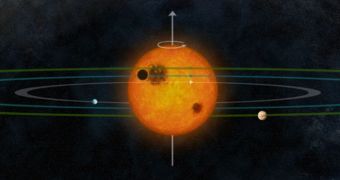Soon after astronomers began detecting multiple extrasolar planets around the same star, they saw that the way in which our solar system is ordered – with each planet occupying a clear position – is not the norm throughout the galaxy, but rather an exception.
In a recent study, a collaboration of researchers managed to discover a nearby system whose planets are just as ordered around the parent star as Earth and the other seven planets in the solar system are around the Sun.
In alien systems, particularly in those containing hot Jupiters, planets tend to take on much more eccentric orbits, interacting with each other constantly, and bumping each other off their previous paths.
A hot Jupiter is a large gas giant that orbits very close to its parent star. The proximity produces very high temperatures on the celestial body, hence the name. In the solar system, the orbits closest to the Sun are occupied by rocky worlds, not gas giants.
A team including experts from the Massachusetts Institute of Technology (MIT), the University of California in Santa Cruz (UCSC) and other institutions was recently able to observe the first exoplanetary system that has ordered orbits. Its parent star is located just 10,000 light-years away.
The Sun-like stellar object, known as Kepler-30, was discovered in datasets relayed back to Earth by the NASA Kepler Telescope. All three exoplanets orbiting this star have regular, co-planar orbits.
“In our solar system, the trajectory of the planets is parallel to the rotation of the Sun, which shows they probably formed from a spinning disc. In this system, we show that the same thing happens,” MIT physics graduate student Roberto Sanchis-Ojeda explains. He was the leader of the new investigation.
Details of the newly found star system were published in this week's issue of the top journal Nature.
The new discovery is “telling me that the solar system isn’t some fluke. The fact that the Sun’s rotation is lined up with the planets’ orbits, that’s probably not some freak coincidence,” MIT associate professor of physics Josh Winn explains. He is also a coauthor of the study paper.
Studying stable planetary orbits could reveal more data about how life evolved in the first place. The process of evolution requires stable planets that are constantly exposed to the same conditions. Otherwise, complex life may have a hard time evolving.

 14 DAY TRIAL //
14 DAY TRIAL //